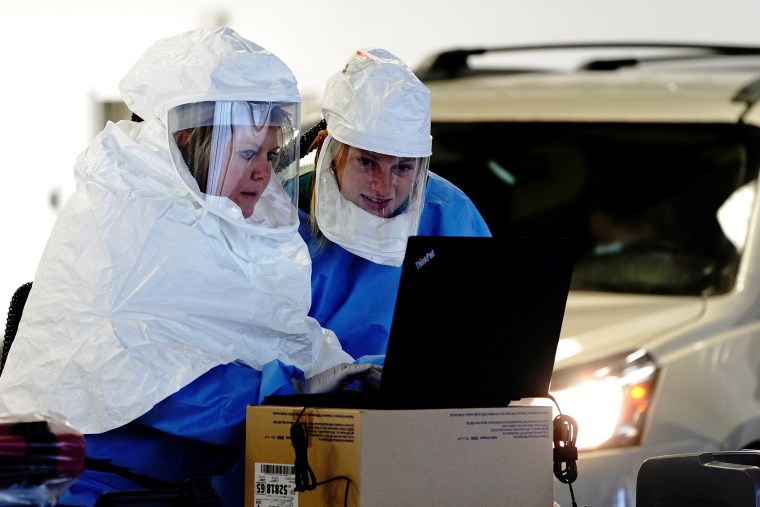Ali Mokdad is tired of hearing about herd immunity.
A former official with the Centers for Disease Control and Prevention, Mokdad spent years training his counterparts in other countries on how to respond to infectious disease outbreaks and how to develop immunization programs. As the idea of natural herd immunity has gained traction, Mokdad has not been shy with his reproach.
Adopting a strategy of natural herd immunity — in which the coronavirus would be allowed to spread particularly among young people until enough of a population becomes immune to the virus to make further spread unlikely — would be catastrophic, he said.
“It’s criminal and it’s unethical,” Mokdad, who is now a professor of global health at the University of Washington, said. “It means we allow many people to die instead of protecting our own. That’s not acceptable.”
Full coverage of the coronavirus outbreak
Most infectious disease experts have been vocal critics of a herd immunity approach but, in recent weeks, the idea has leapt from the fringes into the national consciousness. Last month, the White House openly embraced a herd immunity strategy after three scientists published a controversial online statement, known as the Great Barrington Declaration, that drew immediate pushback from epidemiologists and public health experts.
As the coronavirus surges in most states and hospitalizations for Covid-19 across the country hit record highs, experts say peddling ideas about natural herd immunity is dangerous and muddies what has already been inconsistent public health messaging from the highest levels of government.
“We still have a long way to go to herd immunity, short of a vaccine,” Mokdad said. “If we talk about herd immunity at the current mortality rate that we see from infections, we’re talking at least 1.2 million deaths.”
For this coronavirus, it’s estimated that roughly 60 to 70 percent of the population will need to be immune to reach herd immunity, though Mokdad and others have said that the threshold may be even higher.
There are two main ways that a population can achieve high levels of immunity: Either enough people have been infected by the virus and their immune systems have developed antibodies to protect against future infections, or there is an effective vaccine.
Yet, even in hard-hit regions of the country — such as New York City, which was the epicenter of the pandemic in the spring, or South Dakota, which has imposed few restrictions to curb the virus’s spread and has seen hospitalizations statewide jump by more than 50 percent in just the past week — immunity is thought to be significantly below the levels needed to collectively slow transmissions.
The main premise put forward by the Great Barrington Declaration is that lockdown restrictions that close businesses, schools and other parts of the local economy are not just financially damaging but also carry physical and mental harms. The scientists proposed a strategy of “focused protection” that aims to shield those who are most vulnerable — individuals over the age of 70 and those who have pre-existing conditions that put them at higher risk — while allowing the rest of the population to return to normal life.
The idea is that for those who are thought to be at lower risk of getting seriously ill from Covid-19, lockdown restrictions may do more harm than the virus, according to Jay Bhattacharya, a professor of medicine at Stanford University and one of the co-authors of the declaration.
But critics of the declaration said the most effective way to protect those who are vulnerable is by controlling the amount of community spread.
“Everyone agrees that we should do everything in our power to protect the vulnerable, but it is scientifically clear that right now in the United States and in most other places, if not all, we do not have the tools to protect the vulnerable without controlling transmission in society at large,” Marc Lipsitch, a professor of epidemiology at the Harvard T.H. Chan School of Public Health, said Friday in a podcast discussion about herd immunity hosted by the Journal of the American Medical Association.
Lipsitch along with 79 other public health researchers, epidemiologists and virologists published a letter in the medical journal The Lancet on Oct. 14 refuting the declaration and calling natural herd immunity a “flawed” strategy. The letter became known as the John Snow Memorandum, named after the English physician who is thought to be the father of modern epidemiology.
Dr. Stuart Ray, a professor of medicine at Johns Hopkins University, said that instead of discussing a herd immunity response, which he called “a distracting fiction,” states should focus on strategies that work, such as adopting mask mandates, promoting social distancing, preventing large gatherings and teaching good hand hygiene.
Download the NBC News app for full coverage of the coronavirus outbreak
Adopting a herd immunity strategy also ignores other risks of Covid-19, Ray said, including reports of people who experience lingering symptoms for weeks or months after infection. The true extent of these “long-haulers” is not known, which means it’s too early for scientists to say that the risk of developing serious complications is low enough to make herd immunity a practical response.
“If we allow unchecked spread, we’re allowing some number of people to develop complications, the severity of which we don’t fully understand,” Ray said. “Just because we think there might be a net, doesn’t mean we should step out on a tightrope.”

